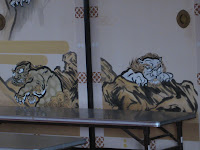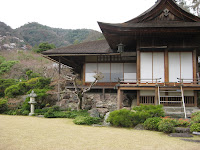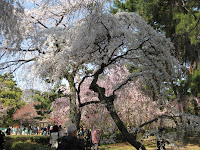We could not believe this was our last full day in Japan! Time had flown by so quickly and we had done so much. This day and evening were packed with activities from beginning to end.
OAT arranged for several taxis to take us on a half-day excursion to the Arashiyama neighborhood, located in west Kyoto. We disembarked near the busy Keifuku Arashiyama train station, walked through attractive neighborhoods, and emerged into the tranquil hillside parks, to visit several significant attractions.



 The principal
The principal 


 landmark, an UNESCO World Heritage Site, was Tenryuji Temple. This is considered the most important Rinzai School Zen temple in Kyoto. Although the original structure dated back to 1339, wars and fires destroyed several reconstructions. The existing building dates from the late 19th century, during the Meiji period. The beautiful grounds include a karesansui (dry rock garden), typical of a Zen temple, as well as lush landscaping. Cherry and other fruit trees were near peak bloom as one can see from the photos.
landmark, an UNESCO World Heritage Site, was Tenryuji Temple. This is considered the most important Rinzai School Zen temple in Kyoto. Although the original structure dated back to 1339, wars and fires destroyed several reconstructions. The existing building dates from the late 19th century, during the Meiji period. The beautiful grounds include a karesansui (dry rock garden), typical of a Zen temple, as well as lush landscaping. Cherry and other fruit trees were near peak bloom as one can see from the photos.


 Next was
Next was  Okochi-Sanso Villa, the hilltop estate of the late movie actor Okochi Denjiro (1898-1962). The road we were walking on to reach the estate passed through the spectacular Sagano bamboo forest. We were able to visit several small shrines and view the exterior of his studio, before having tea in the main villa, now a museum. Many of Okochi's memorabilia were on display. He was best known for his samurai roles, as represented by the poster.
Okochi-Sanso Villa, the hilltop estate of the late movie actor Okochi Denjiro (1898-1962). The road we were walking on to reach the estate passed through the spectacular Sagano bamboo forest. We were able to visit several small shrines and view the exterior of his studio, before having tea in the main villa, now a museum. Many of Okochi's memorabilia were on display. He was best known for his samurai roles, as represented by the poster.


 After tea, we wandered through the estate and adjacent gardens before returning to the Keifuku Arashiyama train station area for a last look around. We had a chance to walk to the Hozu River, where we saw several technologically advanced rickshaws lined up to take passengers around the neighborhood.
After tea, we wandered through the estate and adjacent gardens before returning to the Keifuku Arashiyama train station area for a last look around. We had a chance to walk to the Hozu River, where we saw several technologically advanced rickshaws lined up to take passengers around the neighborhood.We did some last minute shopping before boarding the train back to downtown Kyoto. Machiko guided us through the transfer to the subway at the Kyoto Train Station. The nearest metro stop was only a block or so from the Hearton.



 We decided to spend the
We decided to spend the 


 remainder of the afternoon strolling the grounds of Kyoto Imperial Palace (Kyoto Gosho in Japanese). In our opinion, this park afforded us the best examples of fruit trees in full flower on this trip. It was a great place to people watch, too! Although this was a weekday, there were many locals and
remainder of the afternoon strolling the grounds of Kyoto Imperial Palace (Kyoto Gosho in Japanese). In our opinion, this park afforded us the best examples of fruit trees in full flower on this trip. It was a great place to people watch, too! Although this was a weekday, there were many locals andtourists alike enjoying the day here.




OAT treated us to a fabulous farewell dinner at a shabu shabu

 restaurant, located in the Gion District of east Kyoto. The long table had four inductive-type range burners on which the servers placed large fondue-like pots used to cook our meals. Several of us shared each pot. While the broth was being brought to boiling, they served us appetizers of Japanese eggplant and pickle, followed by prawn and vegetable tempura. We then each placed our sukiyaki-like thinly sliced beef, vegetables, bean curd and noodles into the by-now boiling pots. A light dessert of strawberries and ice cream completed this meal. We were so stuffed! Note: first photo courtesy of Ray.
restaurant, located in the Gion District of east Kyoto. The long table had four inductive-type range burners on which the servers placed large fondue-like pots used to cook our meals. Several of us shared each pot. While the broth was being brought to boiling, they served us appetizers of Japanese eggplant and pickle, followed by prawn and vegetable tempura. We then each placed our sukiyaki-like thinly sliced beef, vegetables, bean curd and noodles into the by-now boiling pots. A light dessert of strawberries and ice cream completed this meal. We were so stuffed! Note: first photo courtesy of Ray.“E.C.” had suggested earlier that each of us prepare a haiku poem to be read to the group after tonight’s dinner. Machiko had passed around some sheets with guidelines on how to write haiku. We learned there are several acceptable formats for this genre of poetry. Most of us took the plunge and read our pieces to the group.



 The Gion District is the best known Geisha district in Kyoto. It is
The Gion District is the best known Geisha district in Kyoto. It is 
 especially charming at night, especially during the cherry blossom season. Note the attractive utility cover. Machiko led the group through this historic preservation district, where the City of Kyoto has illuminated many of the picturesque streets and canals, including the resplendent cherry trees. In all, this walk was a nice finishing touch to this wonderful “Cultural Treasures of Japan” tour!
especially charming at night, especially during the cherry blossom season. Note the attractive utility cover. Machiko led the group through this historic preservation district, where the City of Kyoto has illuminated many of the picturesque streets and canals, including the resplendent cherry trees. In all, this walk was a nice finishing touch to this wonderful “Cultural Treasures of Japan” tour!
No comments:
Post a Comment